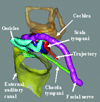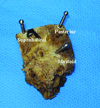Percutaneous cochlear implant drilling via customized frames: an in vitro study
- PMID: 20172392
- PMCID: PMC4425444
- DOI: 10.1016/j.otohns.2009.11.029
Percutaneous cochlear implant drilling via customized frames: an in vitro study
Abstract
Objective: Percutaneous cochlear implantation (PCI) surgery uses patient-specific customized microstereotactic frames to achieve a single drill-pass from the lateral skull to the cochlea, avoiding vital anatomy. We demonstrate the use of a specific microstereotactic frame, called a "microtable," to perform PCI surgery on cadaveric temporal bone specimens.
Study design: Feasibility study using cadaveric temporal bones.
Subjects and methods: PCI drilling was performed on six cadaveric temporal bone specimens. The main steps involved were 1) placing three bone-implanted markers surrounding the ear, 2) obtaining a CT scan, 3) planning a safe surgical path to the cochlea avoiding vital anatomy, 4) constructing a microstereotactic frame to constrain the drill to the planned path, and 5) affixing the frame to the markers and using it to drill to the cochlea. The specimens were CT scanned after drilling to show the achieved path. Deviation of the drilled path from the desired path was computed, and the closest distance of the mid-axis of the drilled path from critical structures was measured.
Results: In all six specimens, we drilled successfully to the cochlea, preserving the facial nerve and ossicles. In four of six specimens, the chorda tympani was preserved, and in two of six specimens, it was sacrificed. The mean +/- standard deviation error at the target was found to be 0.31 +/- 0.10 mm. The closest distances of the mid-axis of the drilled path to structures were 1.28 +/- 0.17 mm to the facial nerve, 1.31 +/- 0.36 mm to the chorda tympani, and 1.59 +/- 0.43 mm to the ossicles.
Conclusion: In a cadaveric model, PCI drilling is safe and effective.
Copyright 2010 American Academy of Otolaryngology-Head and Neck Surgery Foundation. Published by Mosby, Inc. All rights reserved.
Figures








Similar articles
-
Clinical validation study of percutaneous cochlear access using patient-customized microstereotactic frames.Otol Neurotol. 2010 Jan;31(1):94-9. doi: 10.1097/MAO.0b013e3181c2f81a. Otol Neurotol. 2010. PMID: 20019561 Free PMC article.
-
Minimally invasive image-guided cochlear implantation for pediatric patients: clinical feasibility study.Otolaryngol Head Neck Surg. 2014 Apr;150(4):631-7. doi: 10.1177/0194599813519050. Epub 2014 Jan 21. Otolaryngol Head Neck Surg. 2014. PMID: 24449796 Free PMC article.
-
Clinical validation of percutaneous cochlear implant surgery: initial report.Laryngoscope. 2008 Jun;118(6):1031-9. doi: 10.1097/MLG.0b013e31816b309e. Laryngoscope. 2008. PMID: 18401279 Free PMC article.
-
Aspects of temporal bone anatomy and pathology in conjunction with cochlear implant surgery.Acta Radiol Suppl. 2003 Jul;430:2-15. Acta Radiol Suppl. 2003. PMID: 12834396 Review.
-
Cochlear implantation through the middle fossa: an anatomic study for a novel technique.Acta Otolaryngol. 2013 Sep;133(9):905-9. doi: 10.3109/00016489.2013.795291. Epub 2013 Jun 24. Acta Otolaryngol. 2013. PMID: 23795614 Review.
Cited by
-
Validation of minimally invasive, image-guided cochlear implantation using Advanced Bionics, Cochlear, and Medel electrodes in a cadaver model.Int J Comput Assist Radiol Surg. 2013 Nov;8(6):989-95. doi: 10.1007/s11548-013-0842-6. Epub 2013 Apr 30. Int J Comput Assist Radiol Surg. 2013. PMID: 23633113 Free PMC article.
-
Minimally Invasive Cochlear Implantation Assisted by Bi-planar Device: An Exploratory Feasibility Study in vitro.Chin Med J (Engl). 2016 Oct 20;129(20):2476-2483. doi: 10.4103/0366-6999.191787. Chin Med J (Engl). 2016. PMID: 27748341 Free PMC article.
-
An automated insertion tool for cochlear implants with integrated force sensing capability.Int J Comput Assist Radiol Surg. 2014 May;9(3):481-94. doi: 10.1007/s11548-013-0936-1. Int J Comput Assist Radiol Surg. 2014. PMID: 23959671
-
Minimally invasive image-guided access for drainage of petrous apex lesions: a case report.Otol Neurotol. 2014 Apr;35(4):649-55. doi: 10.1097/MAO.0000000000000328. Otol Neurotol. 2014. PMID: 24622019 Free PMC article.
-
Implantation of the completely ossified cochlea: an image-guided approach.Otol Neurotol. 2013 Apr;34(3):522-5. doi: 10.1097/MAO.0b013e31827d8aa0. Otol Neurotol. 2013. PMID: 23370556 Free PMC article.
References
-
- Warren FM, Balachandran R, Fitzpatrick JM, et al. Percutaneous cochlear access using bone-mounted, customized drill guides: demonstration of concept in vitro. Otol Neurotol. 2007;28:325–329. - PubMed
Publication types
MeSH terms
Grants and funding
LinkOut - more resources
Full Text Sources
Other Literature Sources
Miscellaneous

